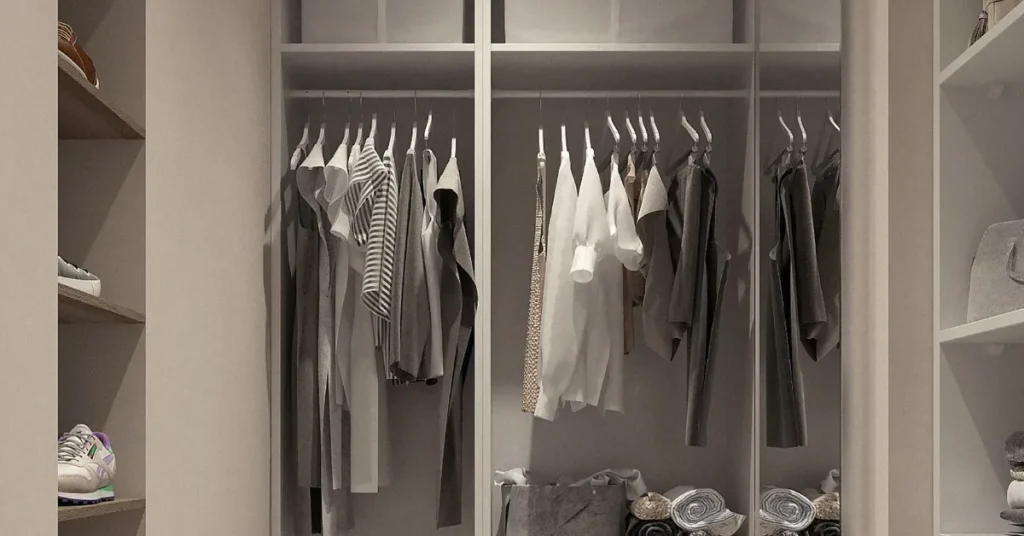A standard closet width is typically 24 inches at minimum. For walk-ins, a width of 6 to 8 feet is common.
Designing a home requires thoughtful consideration of space and utility, especially when it comes to storage areas like closets.
The right closet dimensions can transform a cramped and inefficient bedroom into a spacious sanctuary with ample room for clothing, shoes, and accessories.
Homeowners and builders need to balance the available space against the need for comfortable access and usability. Whether installing a reach-in wardrobe in a small bedroom or crafting a luxurious walk-in for a master suite, understanding the appropriate sizing is crucial.
Ensuring there is enough width not only affects how much can be stored but also the type of door solutions that can be implemented, from sliding doors to traditional hinged varieties.
With the correct width, a closet can significantly enhance the functionality and aesthetic of a space, making it a key consideration in home design and organization.

Ideal Closet Dimensions For Different Room Types
Choosing the right closet size can transform storage and accessibility in your home. An optimal closet design can lead to a more organized and pleasant living space. Find out the ideal closet dimensions for different room types to maximize your home’s potential.
Bedroom Closet Essentials
Bedroom closets cater to various storage needs. Essential dimensions vary based on room size and personal usage.
The standard closet width is 24 inches; however, for a walk-in, aim for at least 36 to 48 inches. This allows enough space for hanging clothes without cramping.
Depth matters as well. For hangers and clothes, you’ll need a minimum of 24 inches. Below is a handy reference:
| Type of Closet | Minimum Width | Recommended Depth |
| Reach-In | 48 inches | 24 inches |
| Walk-In for One | 36 inches | 36 inches |
| Walk-In for Two | 72 inches | 36 inches |
To maximize space, consider adding shelves above the hanging rods and drawers for smaller items.
Hallway And Entryway Storage Solutions
Hallway and entryway closets keep common areas clutter-free. A width of at least 36 inches allows room for coats and daily essentials. The recommended depth here is at least 16 inches. Organization is crucial:
- Install hooks for easy-to-grab items.
- Use shelves for hats and accessories.
- Place a shoe rack at the bottom.
For entryways, consider bench storage or cubbies for added functionality. In tight spaces, a narrow closet with well-planned storage options works wonders.
Maximizing Space In Your Closet Design
Thinking of a closet revamp? The right size is crucial for keeping your clothes and accessories organized. A well-designed closet saves time and keeps your items in top shape. Let’s explore how to maximize every inch of your closet space.
Custom Shelving And Drawers
Custom solutions transform your closet. Adjustable shelving lets you change the layout as your wardrobe evolves. Custom drawers mean neatly sorted items. Here’s how to use them:
- Adjust for height: Place shelves at varied levels to fit different item sizes.
- Drawer dividers: Keep small items tidy with partitions in your drawers.
Use corners for extra shelving to avoid wasted space. Deep drawers are great for bulky items like sweaters.
The Magic Of Multipurpose Hangers
Smart hangers kick clutter to the curb. Multipurpose hangers hold several pieces, maximizing rod space. Look for these types:
- Tiered hangers: Perfect for hanging trousers or skirts.
- Scarf hangers: Keep scarves wrinkle-free and easy to find.
- Belt hangers: Roll belts and hang them tidily.
Invest in slim, non-slip hangers to keep clothes secure. Doubling up on hangers? Use S-hooks to connect them and hang more items.
Standard Closet Measurements For Homes

Finding the perfect closet size for your home hinges on thoughtful design and planning. A well-sized closet balances ample storage space with the room’s overall aesthetics.
Understanding standard closet measurements helps homeowners optimize their storage efficiently and effectively.
Minimum Size Recommendations
Every home needs adequate storage, so closets must meet minimum size standards. The minimum width for a person’s closet should be 24 inches, but this varies based on usage and types of items stored.
- For a coat closet, aim for at least 28 inches in width
- For linen closets: wider is better, think 32 inches or more
Depth is also crucial. For hanging clothes, 24 inches is the minimum needed. Shelves above should be less deep, around 12 inches, to ensure easy access to items. Remember, proper organization within these spaces maximizes utility.
Walk-in Vs. Reach-in Closet Specs
When deciding between walk-in and reach-in closets, dimensions play a critical role.
| Closet Type | Minimum Width | Minimum Depth |
| Reach-In | 48 inches | 24 inches |
| Walk-In | 84 inches | 30 inches |
A reach-in closet is often suitable for smaller spaces and single users. It should be wide enough to allow for side-by-side hanging of clothing.
In contrast, a walk-in closet offers more space and comfort, accommodating multiple users and ample shelving. Depth should accommodate hanging garments with ease.
Regardless of the type, ensure there’s enough room for doors to open comfortably without obstruction. Sliding and bi-fold doors are functional for tighter spaces. Proper lighting and ventilation in a closet also contribute to its functionality.
Design Tips For Small Closet Spaces
Maximizing a small closet requires smart design strategies. Clever organizers and color tactics turn tiny closets into tidy spaces. Start by measuring your closet’s width.
Most experts suggest at least 24 inches for hanging clothes. Small closets benefit from vertical solutions and multi-purpose items. Here are ways to amplify your closet’s efficiency and style:
Innovative Organizers For Efficiency
- Use slim hangers: Thin, velvet-coated hangers save space.
- Add hooks: Place hooks on closet walls to hang accessories.
- Install a double rod: A second rod doubles hanging capacity.
- Try pull-out bins: They make good use of deep closet corners.
- Opt for adjustable shelving: Tailor shelf heights to your needs.
Color Coding And Visual Appeal
Organize by color to quickly find clothes and make your closet pop. Start with light colors on one side and progress to dark. This not only saves time but also pleases the eye. Consider these tips:
- Group clothes by type, then color.
- Use color-coded boxes for accessories.
- Choose clear storage for a clean look.
- Label shelves for easy item retrieval.
Avoiding Common Closet Planning Mistakes

Designing the perfect closet requires careful planning. Many overlook key details that can make or break the functionality of their space. Awareness of common closet planning mistakes ensures a more practical and user-friendly storage area.
Not Accounting For Bulky Items
One-size-fits-all does not apply when designing a closet. Consideration for larger items is essential.
- Measure your bulky items such as luggage, winter coats, or formal dresses.
- Create zones within your closet to accommodate these pieces.
- Adjustable shelves or rods offer the flexibility needed for such items.
- Deep shelving might be necessary for storage bins or boxes.
Personalize your space to ensure no item is left without a home.
Forgetting About Accessibility
Easy access to your items is paramount for a practical closet. Ensure everything is reachable and well-organized.
| Accessibility Tips |
| Place daily-use items at eye levelOpt for sliding doors or curtains over traditional hinged doorsInclude sufficient lighting to find items with easeInstall pull-out drawers for smaller accessories |
A thorough walk-through of your daily routine helps identify the best placement for all your belongings.
FAQs About How Wide Should A Closet Be
What Are Good Dimensions For A Closet?
Ideal closet dimensions typically measure at least 24 inches in depth, and 72 inches in height. Width can vary, but 48 inches accommodates various storage needs effectively.
Is 2 Feet Wide Enough For A Closet?
A 2-foot wide closet is typically not wide enough for hanging garments comfortably. It’s better suited for storage of narrow items or small accessories.
What Is The Minimum Size For A Walk-in Closet?
The minimum size for a walk-in closet is typically 4 feet (1. 22 meters) by 4 feet (1. 22 meters). This allows for comfortable movement and storage space.
Can A Closet Be 3 Feet Wide?
Yes, a closet can be 3 feet wide. This width is suitable for small spaces and often accommodates a single row of garments.
Conclusion
Deciding on the ideal closet width balances functionality and space. Aim for at least 24 inches, but if storage needs are substantial, go wider.
Personalize to suit your wardrobe and room size. Always measure, plan, and then build or buy.
Your perfect closet solution awaits.
Resources:
1. https://basc.pnnl.gov/resource-guides/air-handler-closet-retrofit
